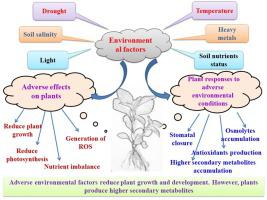Journal of Applied Research on Medicinal and Aromatic Plants ( IF 3.8 ) Pub Date : 2020-04-28 , DOI: 10.1016/j.jarmap.2020.100255 Mitali Mahajan , Raju Kuiry , Probir K. Pal

|
Abiotic stresses are the most critical hurdle for the growth and development of the plants. The abiotic stresses are salinity, heat, drought, flood, heavy metals and plant nutrients. Plants develop different tolerance mechanisms such as adjustment of membrane system, maintenance of cell wall architecture, production of secondary metabolites and antioxidants, phytohormones, and accumulation of osmolytes in response to abiotic stresses. The secondary metabolites, developed through various physiological and biochemical process, play vital role to cope up with different stresses. The presence of these compounds in the plant acts as an interface with its adverse environment. Primary metabolites are the precursors for the secondary metabolites production in plants, but its concentration and transport are influenced with the changes in climatic conditions. Stress conditions also enhance the expression level of corresponding genes involved in the natural product biosynthesis. The secondary metabolites produced as a result of abiotic stresses are involved in plant defence system for survival. Secondary metabolites never participate in building block processes rather they function to deal with many external agents. They also protect plant from various biotic stresses and facilitate in pollination and fruit dispersal mechanism by attracting the pollinating and dispersing agent through their beautiful colour and fragrance. In this review, we tried to figure out how abiotic stresses affect the production of secondary metabolites in medicinal and aromatic plants.
中文翻译:

了解环境胁迫对药用植物和芳香植物中次生代谢产物积累的影响
非生物胁迫是植物生长发育的最关键障碍。非生物胁迫是盐度,高温,干旱,洪水,重金属和植物养分。植物发展出不同的耐受机制,例如调节膜系统,维持细胞壁结构,产生次级代谢产物和抗氧化剂,植物激素以及响应非生物胁迫而产生的渗透物积累。通过各种生理和生化过程产生的次生代谢产物在应对不同压力方面起着至关重要的作用。这些化合物在植物中的存在与其有害环境有关。初级代谢产物是植物中次级代谢产物产生的前体,但是其浓度和运输受到气候条件变化的影响。胁迫条件也提高了参与天然产物生物合成的相应基因的表达水平。由于非生物胁迫而产生的次生代谢产物参与植物防御系统的生存。次生代谢物从不参与构建模块过程,而是发挥作用来应对许多外部因素。它们还通过其美丽的色彩和香气吸引授粉和分散剂,从而保护植物免受各种生物胁迫,并促进授粉和果实的分散机制。在这篇综述中,我们试图找出非生物胁迫如何影响药用和芳香植物中次生代谢产物的产生。胁迫条件也提高了参与天然产物生物合成的相应基因的表达水平。由于非生物胁迫而产生的次生代谢产物参与植物防御系统的生存。次生代谢物从不参与构建模块过程,而是发挥作用来应对许多外部因素。它们还通过其美丽的色彩和香气吸引授粉和分散剂,从而保护植物免受各种生物胁迫,并促进授粉和水果分散机制。在这篇综述中,我们试图找出非生物胁迫如何影响药用和芳香植物中次生代谢产物的产生。胁迫条件也提高了参与天然产物生物合成的相应基因的表达水平。由于非生物胁迫而产生的次生代谢产物参与植物防御系统的生存。次生代谢物从不参与构建模块过程,而是发挥作用来应对许多外部因素。它们还通过其美丽的色彩和香气吸引授粉和分散剂,从而保护植物免受各种生物胁迫,并促进授粉和水果分散机制。在这篇综述中,我们试图找出非生物胁迫如何影响药用植物和芳香植物中次生代谢产物的产生。由于非生物胁迫而产生的次生代谢产物参与植物防御系统的生存。次生代谢物从不参与构建模块过程,而是发挥作用来应对许多外部因素。它们还通过其美丽的色彩和香气吸引授粉和分散剂,从而保护植物免受各种生物胁迫,并促进授粉和水果分散机制。在这篇综述中,我们试图找出非生物胁迫如何影响药用植物和芳香植物中次生代谢产物的产生。由于非生物胁迫而产生的次生代谢产物参与植物防御系统的生存。次生代谢物从不参与构建模块过程,而是发挥作用来应对许多外部因素。它们还通过其美丽的色彩和香气吸引授粉和分散剂,从而保护植物免受各种生物胁迫,并促进授粉和水果分散机制。在这篇综述中,我们试图找出非生物胁迫如何影响药用和芳香植物中次生代谢产物的产生。它们还通过其美丽的色彩和香气吸引授粉和分散剂,从而保护植物免受各种生物胁迫,并促进授粉和水果分散机制。在这篇综述中,我们试图找出非生物胁迫如何影响药用植物和芳香植物中次生代谢产物的产生。它们还通过其美丽的色彩和香气吸引授粉和分散剂,从而保护植物免受各种生物胁迫,并促进授粉和水果分散机制。在这篇综述中,我们试图找出非生物胁迫如何影响药用植物和芳香植物中次生代谢产物的产生。











































 京公网安备 11010802027423号
京公网安备 11010802027423号